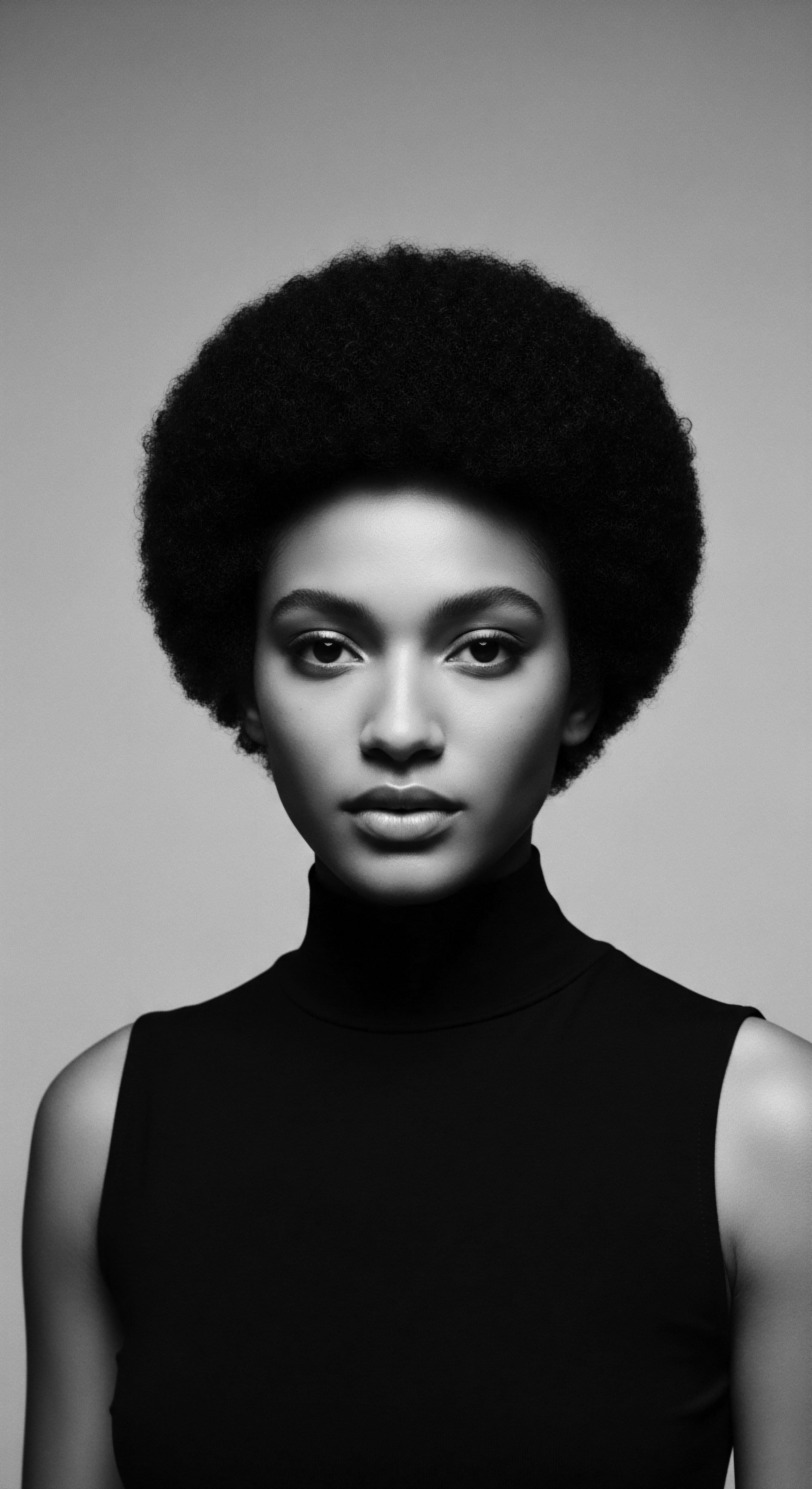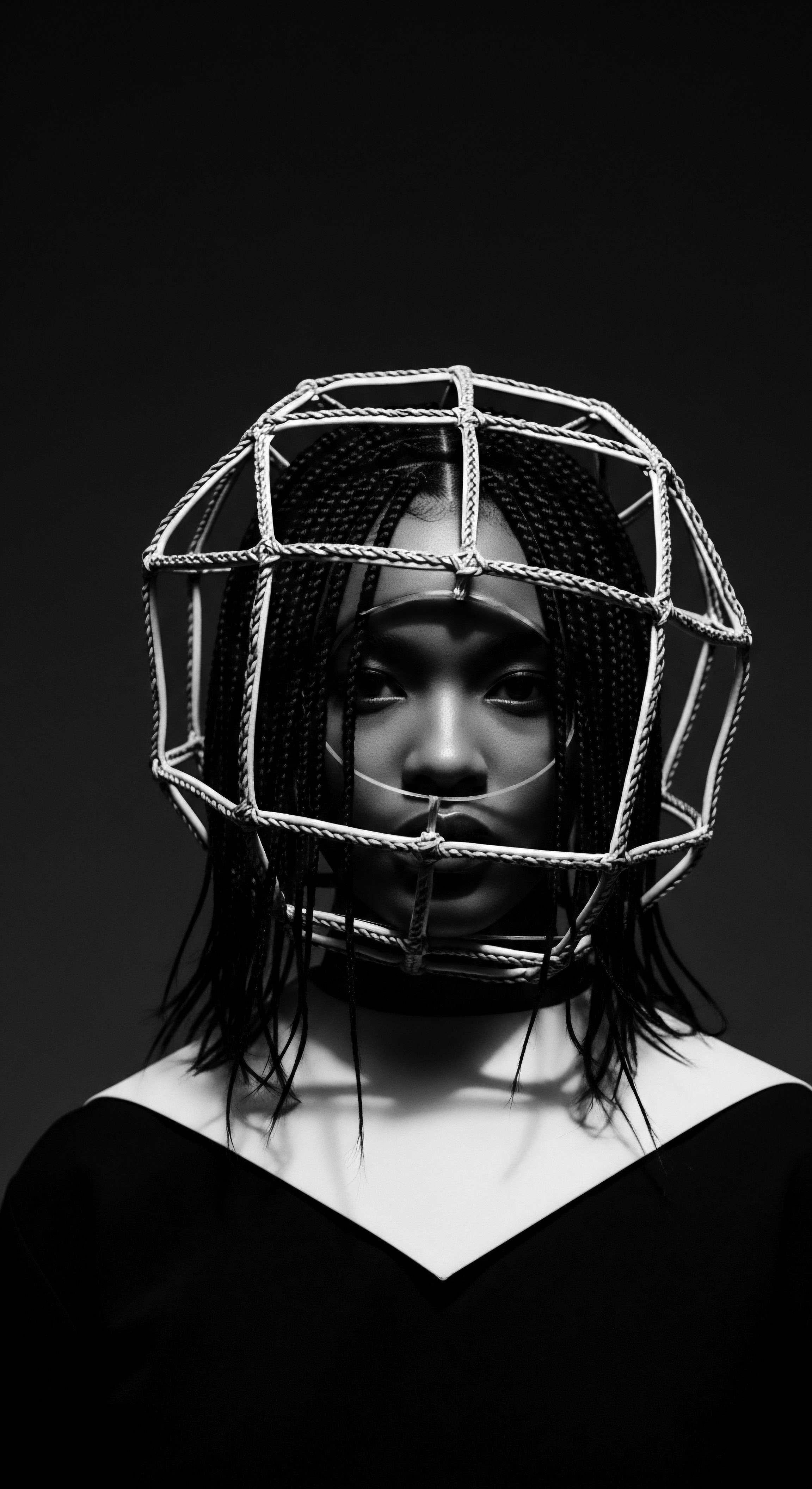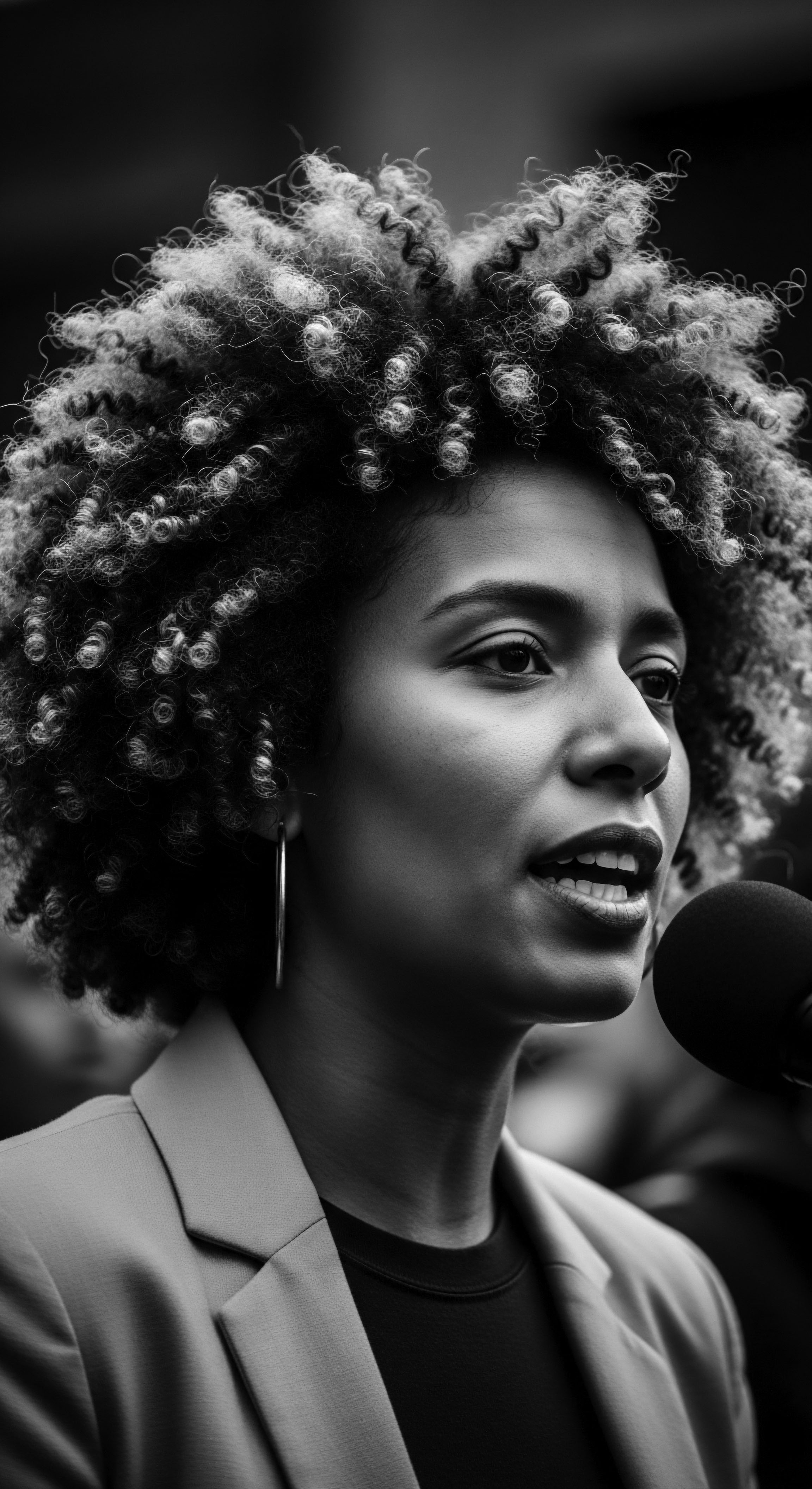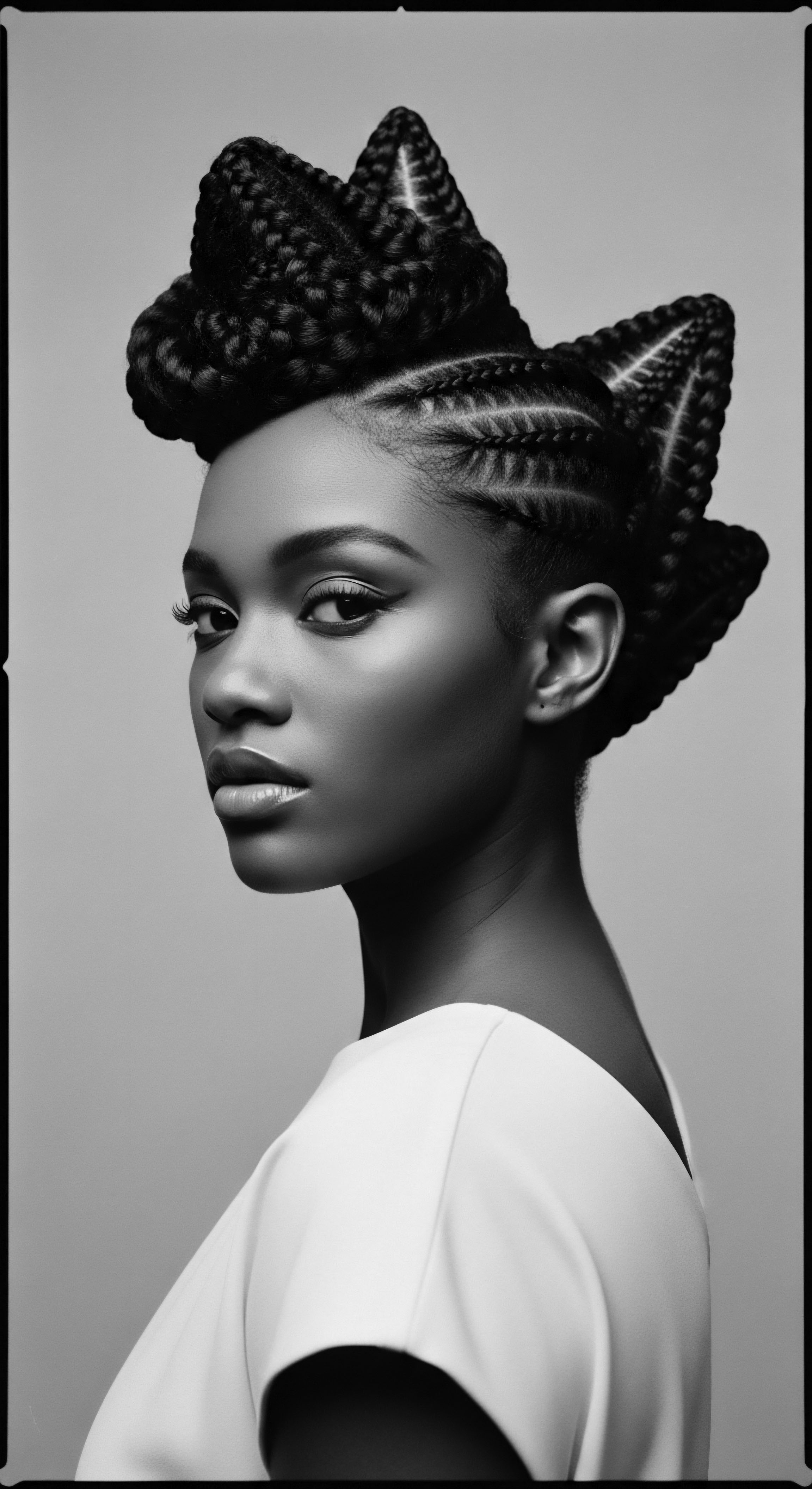
Roots
The very strands that crown our heads, particularly those with a textured coil or a generous ripple, carry within them echoes of beginnings, of sun-drenched landscapes, and the whispers of generations past. To truly grasp the modern scientific understanding of hair structure, especially for hair born of Black and mixed-race lineage, we must first journey backward, tracing the living history held within each curl. This exploration is not a mere recounting of facts; it is an invitation to listen to the hair itself, a silent storyteller of human adaptation, communal wisdom, and enduring beauty. Each bend and twist in a textured strand holds not only protein bonds but also the indelible markings of ancestral ingenuity and resilience, a testament to how ancient practices laid foundational insights that modern science now illuminates.

What Creates the Distinct Coil of Textured Hair?
At the elemental level, the very shape of a hair strand is determined before it ever breaks the surface of the scalp, deep within the hair follicle. For straight hair, the follicle maintains a relatively circular opening, allowing the strand to emerge evenly. However, for hair with a significant curl, the follicle possesses an oval or even flatter, elliptical shape. This asymmetry dictates that the hair strand will twist as it grows, creating the characteristic bends, waves, and coils we recognize as textured hair.
The tighter the curl, the more pronounced this follicular curvature becomes. This initial blueprint, set by our genetic inheritance, acts as the primary architect of a strand’s journey.
Beyond the follicle’s geometry, the internal architecture of the hair strand plays a significant role. The hair itself consists primarily of Keratin, a robust fibrous protein. Within this keratin, sulfur atoms are present, forming crucial connections called disulfide bonds. In straight hair, these disulfide bonds are spread more uniformly.
For curly and coily hair, however, these bonds are more numerous and positioned closer together, creating internal tension that compels the strand to curl and twist. This uneven distribution of keratin along the hair shaft causes the hair to bend where the protein layers are denser, thinning where they are less so, creating natural movement along the strand. This internal tension contributes to the hair’s coiled appearance.
The fundamental shape of textured hair, from its elliptical follicle to its intricate disulfide bonds, stands as a biological chronicle of human adaptation.
Considering this biological design through a historical lens, some evolutionary experts propose that highly textured hair was the original hair type for modern humans, serving an adaptive need for protection against intense ultraviolet radiation in hot, sunny climates. The coils provide insulation to the scalp while simultaneously allowing heat to escape, a remarkably efficient natural shield.

How Do We Name the Threads of Textured Hair?
The language we use to describe textured hair has shifted over time, influenced by cultural context and societal perspectives. Modern systems often categorize hair into types (e.g. 2, 3, 4, with subcategories A, B, C), based on the tightness of the curl pattern.
While these systems offer a scientific framework for product formulation and care recommendations, it is vital to remember their relatively recent origin and the broader spectrum of hair heritage they aim to encompass. Earlier understandings of hair, particularly within African societies, did not rely on such rigid classifications but rather on recognition of diverse forms and their cultural meanings.
- Irun Kiko ❉ A traditional Yoruba thread-wrapping style, signifying femininity, marriage, or rites of passage.
- Cornrows ❉ Ancient braiding patterns found in African sculptures, serving as cultural markers and, historically, even maps for escape.
- Fulani Braids ❉ A style from the Fulani people of West Africa, adorned with beads and cowrie shells, representing wealth and social status.
These terms, deeply rooted in the heritage of specific communities, speak to an understanding of hair that transcends mere texture. They are not classifications but celebrations, connecting an individual to their lineage and community.

What Lifecycles Govern Textured Hair Growth?
Like all human hair, textured hair follows a cycle of growth (anagen), regression (catagen), and rest (telogen). However, studies reveal distinct differences in hair growth parameters when comparing textured hair to other hair types. For instance, research by Loussouarn et al. (2001) found that hair density in individuals of African descent averaged around 190 hairs per square centimeter, which is lower than the average of 227 hairs per square centimeter observed in Caucasians.
Furthermore, this study indicated that African hair grows at a slower rate, approximately 256 ± 44 micrometers per day, compared to Caucasian hair at 396 ± 55 micrometers per day. These scientific observations, while clinical, lend weight to the historical understanding that textured hair may be more prone to visible length retention challenges and requires specific approaches to encourage growth and minimize breakage.
Ancestral practices intuitively addressed many of these physiological considerations. The emphasis on protective styles, gentle manipulation, and the use of natural emollients were not just aesthetic choices but also a response to the inherent properties of textured hair. They understood the necessity of careful tending to preserve length and maintain scalp health, a wisdom passed down through generations.

Ritual
The tending of hair is a profound, living tradition, especially within communities that carry the legacy of textured strands. Here, the ancestral practices of styling, adornment, and transformation move beyond simple aesthetics. They become acts of connection, of cultural preservation, and a deeply felt language of self, all while working in concert with the very biology of the hair itself. The methods, honed through centuries, echo modern scientific understanding of how best to safeguard and enhance textured hair.

What Protective Styles Offer Our Heritage?
Protective styles, a cornerstone of textured hair care, possess a rich historical lineage that extends across continents and generations. These styles—including Braids, Twists, Locs, and Cornrows—were not merely decorative. In ancient African societies, they functioned as complex visual markers, communicating identity, social status, age, marital status, and even spiritual beliefs. For example, specific braiding patterns among the Yoruba people held deep spiritual meaning, often performed by skilled artisans who were highly respected within their communities.
During the transatlantic slave trade, when attempts were made to strip enslaved Africans of their cultural identity, these styles became a form of resistance and survival. Cornrows, for instance, were reportedly used to conceal rice seeds for cultivation in new lands or even to encode maps for escape routes, a silent defiance against oppression.
From a scientific viewpoint, protective styles serve to minimize physical manipulation, reduce exposure to environmental stressors, and thus prevent breakage. Textured hair, with its natural bends and twists, possesses points of weakness along the hair shaft, making it more prone to breakage from tugging and pulling. By gathering and securing the hair, these styles shield the delicate strands, allowing for length retention. This ancestral knowledge of safeguarding hair aligns perfectly with contemporary trichological principles that advocate for low-manipulation styles to promote hair health.
Protective styles, born of ancestral ingenuity, offer a tangible link between historical resilience and modern hair health, preserving delicate strands through mindful artistry.
| Traditional Practice Braiding and Twisting to signal status and protect hair from the elements. |
| Modern Scientific Understanding Reduces daily manipulation and mechanical stress on hair strands, minimizing breakage points inherent to textured hair. |
| Traditional Practice Use of Natural Oils and Butters (e.g. shea butter) for moisture retention in harsh climates. |
| Modern Scientific Understanding Emollients and occlusives create a barrier that slows moisture evaporation, crucial for textured hair that struggles with sebum distribution. |
| Traditional Practice Head Wraps and Bonnets used for adornment and protection. |
| Modern Scientific Understanding Creates a smooth, low-friction surface for hair during sleep or daily activity, preventing tangles and breakage from friction. |
| Traditional Practice Ancestral wisdom concerning hair protection laid the groundwork for contemporary practices, recognizing the hair's unique needs. |

How Did Ancestors Define Natural Hair?
Defining textured hair has long been an art, a careful dance with the hair’s natural inclination. Many ancestral methods of defining curls relied on gentle manipulation and the strategic application of natural substances rather than harsh chemicals or excessive heat. While modern techniques involve specific gels and creams, the underlying principle remains the same ❉ encouraging the natural curl pattern to form and hold.
Consider the ancient use of oils and butters, common across African and South Asian traditions, to soften strands and promote curl definition. In West African traditions, for instance, oils and butters were regularly used to keep hair moisturized in hot, dry climates, often paired with protective styles to maintain length and health. These practices, while rooted in cultural rituals, intuitively understood the hair’s need for hydration. Modern science confirms that textured hair, with its coiled structure and uneven sebum distribution from the scalp, struggles to retain moisture.
The application of oils helped to seal in hydration, giving the curls a more defined appearance and reducing frizz. The act of gently coiling or twisting sections of hair by hand, passed down through generations, effectively encourages the disulfide bonds within each strand to align in their natural curl pattern.

What Role Do Wigs and Extensions Play in Heritage?
The use of wigs and hair extensions is not a modern invention; it is a practice with deep historical roots, particularly visible in ancient civilizations. In ancient Egypt, both men and women of the elite class frequently wore elaborate wigs made from human hair, wool, or plant fibers. These wigs were often intricately braided and adorned with precious materials, signifying wealth, social status, and religious devotion. Some Egyptians even removed their natural hair entirely or kept it cropped, wearing wigs over it for protection against lice and for aesthetic purposes.
These historical applications of wigs and extensions align with modern understandings of hair care. Wigs provided a layer of protection for natural hair, minimizing exposure to the elements and daily manipulation, which can lead to damage. Extensions allowed for versatility in styling and the creation of elaborate looks, much as they do today. The continuity of this practice speaks to a timeless desire for aesthetic expression, coupled with an underlying understanding of hair health and protection.

Relay
The story of textured hair, so deeply intertwined with heritage, does not stand still. It is a living archive, continuously relaying ancestral wisdom into contemporary understanding, transforming mere routine into a holistic regimen. The modern scientific lens, far from dismissing these deep-rooted practices, often validates their efficacy, allowing us to build care strategies that honor both ancient knowledge and new discoveries. It is within this dynamic interplay that the full spectrum of textured hair’s resilience and beauty comes into sharp focus.

How Can Ancient Wisdom Guide Our Current Hair Regimen?
Building a personalized hair regimen for textured hair becomes a journey of understanding the hair’s intrinsic needs, a journey often illuminated by the ancestral paths walked before us. Historically, the emphasis was on consistent care, often incorporating natural ingredients readily available from the land. This approach aligns with modern trichology, which prioritizes a balanced routine to maintain hair health. The challenges textured hair faces, such as dryness due to the difficulty of natural oils (sebum) traveling down coiled strands, were intuitively addressed through practices like regular oiling.
Consider the widespread practice of Hair Oiling across various ancient cultures, particularly in South Asia and parts of Africa. In Ayurvedic traditions, dating back thousands of years, hair oiling was a sacred practice involving massaging natural oils into the scalp and hair to nourish, strengthen, and promote relaxation. This practice also existed in ancient Egypt, where castor oil and almond oil were staples for conditioning and strengthening hair. West African traditions used oils and butters to moisturize hair in hot, dry climates.
From a scientific perspective, these oils serve as emollients and occlusives, sealing moisture into the hair shaft and providing lubrication that reduces friction between strands, thereby minimizing breakage. This ancestral application of lipids directly addresses one of the primary needs of textured hair ❉ intense hydration.
Ancestral hair oiling practices, rooted in cultural rituals, provide a scientifically sound foundation for contemporary textured hair hydration and protection.
The layering method, often referred to today as the L.O.C. (Liquid, Oil, Cream) or L.C.O. (Liquid, Cream, Oil) method, finds a quiet echo in these long-standing traditions. While the specific sequence may not have been formally codified, the idea of applying hydrating substances followed by emollients to seal in moisture was an inherent part of ancestral care, a practical response to environmental conditions and hair characteristics.

Why is Nighttime Care a Sacred Ritual?
The ritual of nighttime hair protection holds a particularly deep resonance within textured hair heritage, moving beyond mere convenience to become a cultural imperative. The use of head wraps and bonnets at night, commonly practiced across generations, has a historical basis intertwined with identity and resistance. For instance, the 18th-century Tignon Laws in Louisiana mandated that Black women conceal their hair in public, forcing them to wear head coverings. What began as an oppressive measure was often transformed by Black women into an expression of creativity and dignity, making the headwrap a symbol of defiance and beauty.
From a scientific standpoint, the wisdom of nighttime hair protection is undeniable. Sleeping directly on cotton pillowcases can cause friction, leading to frizz, tangles, and breakage, especially for delicate textured strands. Silk or satin bonnets and pillowcases create a smooth surface that reduces this friction, allowing the hair to glide rather than snag. This minimizes cuticle damage, preserves moisture, and maintains curl definition overnight.
The smooth surface also prevents moisture from being absorbed from the hair by the fabric. This thoughtful practice, passed down through families, effectively safeguards the integrity of the hair shaft, prolonging the life of styles and supporting overall hair health.
- Hair Growth Rate ❉ A study (Loussouarn et al. 2001) found that African hair grows at a significantly slower rate (256 ± 44 μm per day) compared to Caucasian hair (396 ± 55 μm per day). This highlights the importance of practices that minimize breakage to retain length.
- Disulfide Bonds ❉ The high concentration of these bonds in textured hair creates its curl pattern, but also makes it susceptible to certain types of damage if not properly cared for during chemical or heat styling.
- Moisture Retention ❉ The helical structure of textured hair makes it difficult for natural oils to travel down the hair shaft, leading to increased dryness. This underscores the ancestral emphasis on hydrating ingredients.

Which Ingredients Echo Ancestral Wisdom?
The ingredients central to textured hair care, both ancient and contemporary, offer a compelling demonstration of ancestral wisdom aligning with modern science. Across Africa and the diaspora, natural ingredients were chosen for their perceived benefits, a selection often validated by contemporary research.
- Shea Butter ❉ Derived from the nuts of the African shea tree, shea butter has been a staple for centuries for its emollient properties. Scientifically, it is rich in fatty acids and vitamins, providing deep moisture and acting as a sealant for hair, crucial for textured hair that struggles with moisture retention.
- Castor Oil ❉ Used in ancient Egypt to nourish and strengthen hair, castor oil continues to be valued for its thick consistency and purported ability to promote hair growth and scalp health. Its ricinoleic acid content is believed to contribute to its conditioning effects.
- Coconut Oil ❉ A common ingredient in South Asian hair oiling traditions, coconut oil is known for its ability to penetrate the hair shaft, reducing protein loss and providing deep conditioning.
These ancestral choices were not random; they were observations of nature’s bounty and their effects on the hair, forming a practical ethnobotany that supported generations.

How Does Holistic Wellness Shape Our Hair’s Future?
The ancestral understanding of hair health often extended beyond topical applications, embracing a holistic view where hair was seen as an indicator of overall well-being. This perspective, deeply woven into many indigenous and African wellness philosophies, connects hair health to internal nutrition, emotional balance, and spiritual harmony.
For instance, ancient Egyptian texts included remedies for hair growth and combating baldness, showing an early concern for hair vitality that linked to broader health practices. Similarly, Ayurvedic principles, which influence many traditional hair care practices, emphasize balance between body, mind, and spirit for maintaining overall equilibrium, including hair health. Modern science supports this interconnectedness. Nutrition, stress levels, and systemic health conditions all profoundly impact hair growth cycles, shaft integrity, and scalp health.
A diet rich in essential vitamins, minerals, and proteins directly contributes to the building blocks of strong hair. Chronic stress can push hair prematurely into the resting phase, leading to increased shedding.
The ancestral approach of seeing hair not as an isolated appendage but as an integral part of the self and one’s connection to the world finds profound validation in today’s comprehensive understanding of human physiology. It encourages a mindful care routine that considers not just what we apply to our strands, but how we nourish our bodies and minds, and how we connect to our heritage.

Reflection
To journey through the history and science of textured hair is to confront a vibrant, living archive, where each coil and wave holds stories of resilience, artistry, and profound understanding. Our ancestors, through generations of keen observation and intuitive care, developed practices that, while unburdened by modern scientific nomenclature, precisely addressed the unique biology of textured hair. They understood the delicate balance required for these strands to thrive—the need for moisture, the wisdom of protective styles, the power of natural ingredients.
What modern science now measures in micrometers and disulfide bonds, our forebears knew through touch, tradition, and generational transmission. The oval follicle, the uneven keratin distribution, the challenge of sebum traversal—these were not abstract concepts, but lived realities that informed rituals of oiling, braiding, and head wrapping. These practices, once acts of survival and cultural preservation, now stand as powerful affirmations of heritage, offering timeless blueprints for care.
The soul of a strand, then, is not merely its physical composition; it is the enduring spirit of ingenuity, cultural pride, and unwavering beauty, passed down through the tender thread of time. Our understanding of textured hair is a testament to the fact that profound knowledge can blossom from both ancient wisdom and contemporary inquiry, creating a continuum of care that celebrates every unique helix.

References
- Afriklens. (2024). African Hairstyles ❉ Cultural Significance and Legacy.
- Clinikally. (2024). Reviving Ancient Hair Rituals ❉ Exploring the Therapeutic Art of Hair-Oiling.
- Curl Witch. (2024). The Science Behind Hair Texture ❉ Unraveling the Mysteries.
- EBSCO Research Starters. (n.d.). Afro-textured hair.
- Geeshair. (2024). About African Wooden Combs.
- Lordhair.com. (2023). The Historical Journey of Black Hair.
- Loussouarn, G. et al. (2001). African hair growth parameters. British Journal of Dermatology, 145(2), 294-297.
- Myavana. (2024). The Science Behind Hair Texture ❉ Unraveling the Mysteries.
- Noma Sana. (2025). The Science Behind Textured Hair ❉ Why It Needs Different Care.
- Our Ancestories. (2025). Braids, Beads, and Beauty ❉ Exploring African Hair Traditions With Your.
- TheCollector. (2022). Ancient Egypt’s Most Indulgent Beauty Secrets.
- True Hairdressing. (2024). Curly or straight ❉ What determines hair shape?
